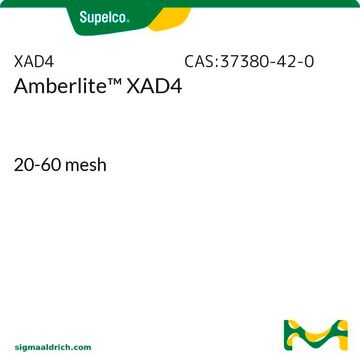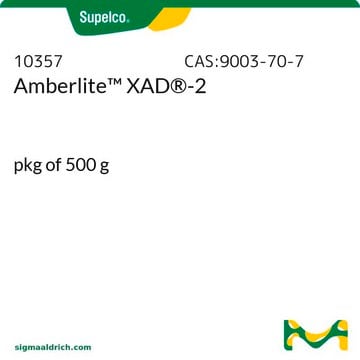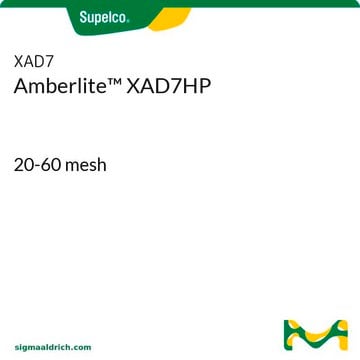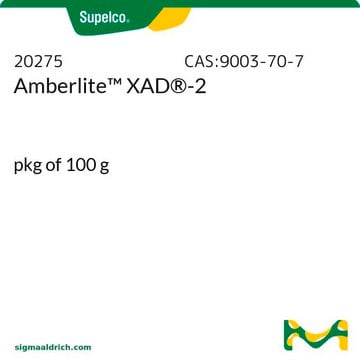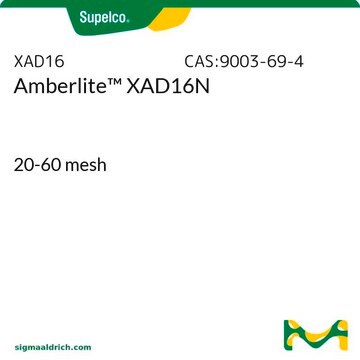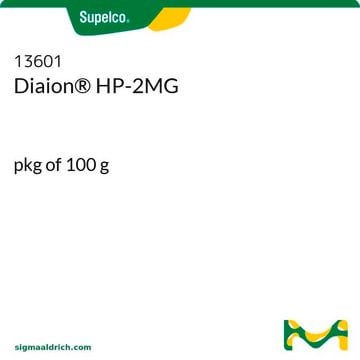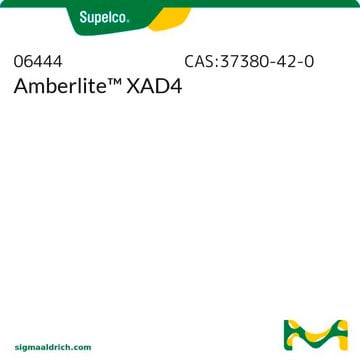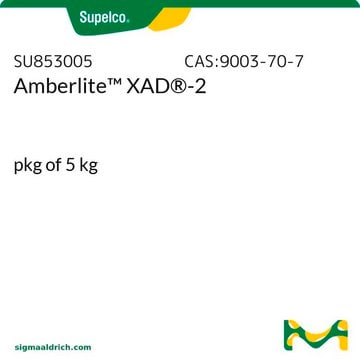Recommended Products
form
solid
autoignition temp.
800 °F
packaging
pkg of 100 g
technique(s)
HPLC: suitable
LPLC: suitable
surface area
750 m2/g
matrix
styrene-divinylbenzene
matrix active group
polymer
particle size
20-60 mesh
pore size
~0.98 mL/g pore volume
100 Å mean pore size
density
1.02 g/mL (true wet)(lit.)
1.08 g/mL (skeletal)(lit.)
separation technique
reversed phase
Looking for similar products? Visit Product Comparison Guide
General description
Amberlite XAD4 is a nonpolar absorbent used for stripping and concentration of organic compounds. Bacillus subtilis immobilized on Amberlite XAD-4 has been investigated as new biosorbent in trace metal determination.
Nonionic macroreticular resin that adsorbs and releases ionic species through hydrophobic and polar interactions; usually used under isocratic conditions.
Application
- Amberlite™ XAD4 was used in rapid fractionation technique.
- Amberlite XAD4 was used as sorbent for HPLC analysis.
Polyaromatic adsorbent for small hydrophobic compounds, surfactants, pharmaceutical manufacturing, phenols, chlorinated organics, pesticide removal and recovery, and organic removal from aqueous food streams.
Other Notes
Two particle sizes are available:
Mesh 20-60 are Cat. Nos. 20276, 10358, XAD4
Mesh 20-50 is Cat. No. 06444
Mesh 20-60 are Cat. Nos. 20276, 10358, XAD4
Mesh 20-50 is Cat. No. 06444
Legal Information
Amberlite is a trademark of DuPont de Nemours, Inc.
Storage Class Code
11 - Combustible Solids
WGK
WGK 3
Flash Point(F)
Not applicable
Flash Point(C)
Not applicable
Personal Protective Equipment
dust mask type N95 (US), Eyeshields, Gloves
Choose from one of the most recent versions:
Already Own This Product?
Find documentation for the products that you have recently purchased in the Document Library.
Customers Also Viewed
Characterization and applications of Amberlite XAD-4 in preparative liquid chromatography
Pietrzyk, D. J., and J. D. Stodola
Analytical Chemistry, 53, 1822-1828 (1981)
Valfredo Azevedo Lemos et al.
Environmental monitoring and assessment, 171(1-4), 163-169 (2009-12-17)
Amberlite XAD-4 resin functionalized with β-nitroso-α-naphthol was applied to an online system for the preconcentration and determination of uranium. U (VI) ions were retained on the minicolumn at an appropriate pH and then desorbed with acid solution. The amount of
Imam Bakhsh Solangi et al.
Journal of hazardous materials, 171(1-3), 815-819 (2009-07-18)
Fluoride in drinking water above permissible level is responsible for human being affected by skeletal fluorosis. In this study, Amberlite XAD-4 has been modified by introducing amino group onto the aromatic ring for its application in fluoride remediation. Characterization of
Passively capturing air data on more volatile chemicals.
Kellyn Betts
Environmental science & technology, 43(4), 978-978 (2009-03-27)
Siva Sarathy et al.
Water research, 44(14), 4087-4096 (2010-06-18)
The advanced oxidation process utilizing ultraviolet and hydrogen peroxide (UV/H(2)O(2)) is currently applied in commercial drinking water applications for the removal of various organic pollutants. Natural organic matter (NOM) present in the source water can also be oxidized and undergo
Our team of scientists has experience in all areas of research including Life Science, Material Science, Chemical Synthesis, Chromatography, Analytical and many others.
Contact Technical Service